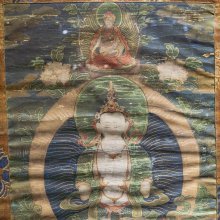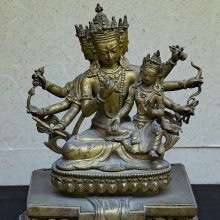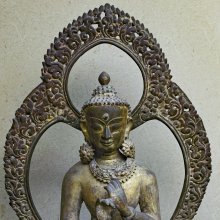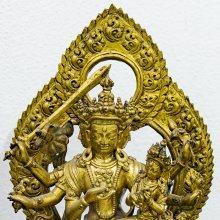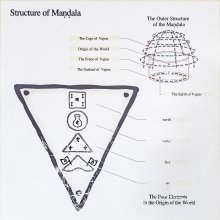Mahavairocana, Mahāvairocana, Maha-vairocana: 1 definition
Introduction:
Mahavairocana means something in Buddhism, Pali. If you want to know the exact meaning, history, etymology or English translation of this term then check out the descriptions on this page. Add your comment or reference to a book if you want to contribute to this summary article.
Alternative spellings of this word include Mahavairochana.
Images (photo gallery)
In Buddhism
Tibetan Buddhism (Vajrayana or tantric Buddhism)
Source: Brill: Śaivism and the Tantric Traditions (tantric Buddhism)Mahāvairocana (महावैरोचन) is the name of a deity, according to the Nāmamantrārthāvalokinī by Vilāsavajra, which is a commentary on the Nāmasaṃgīti.—Accordingly, [while describing Mahāvairocana]—“And then [the Sādhaka should visualise] Mahāvairocana on the principal seat, generated by means of the syllable āḥ. [Why has he four faces?] Since consciousness—which is of the nature of the Dharma-Sphere since, by its nature, it lacks such forms as the grasped [i.e., the subject-object duality]—is four-faced. [This is] because the four liberation faces [/doors]—emptiness and the rest—are the cause of the origination of all meditative concentrations, [and this in turn is] because their ground is the Dharma-Sphere. [...]”.

Tibetan Buddhism includes schools such as Nyingma, Kadampa, Kagyu and Gelug. Their primary canon of literature is divided in two broad categories: The Kangyur, which consists of Buddha’s words, and the Tengyur, which includes commentaries from various sources. Esotericism and tantra techniques (vajrayāna) are collected indepently.
See also (Relevant definitions)
Partial matches: Vairocana, Maha.
Starts with: Mahavairocana Tantra.
Full-text (+18): Buddhaguhya, Mahavairocana Tantra, Vajradhatumahamandala, Caturmukha, Citta, Svabhavatva, Nirabharana, Pradhana, Akaraviraha, Santacitta, Prajnopaya, Bodhyagri, Prakriti, Durgatiparishodhana, Makuta, Shukla, Shuklavarna, Shantacittatva, Atmakatva, Jata.
Relevant text
Search found 4 books and stories containing Mahavairocana, Mahāvairocana, Mahā-vairocana, Maha-vairocana; (plurals include: Mahavairocanas, Mahāvairocanas, vairocanas). You can also click to the full overview containing English textual excerpts. Below are direct links for the most relevant articles:
Day by Day (Dharma lectures) (by Stephen L. Klick)
Vietnamese Buddhist Art (by Nguyen Ngoc Vinh)
7. Buddhist monuments in Indonesia and Borobudur < [Chapter 2 - Similarity of Buddhist monuments in South Vietnam and South East Asia]
Tibet (Myth, Religion and History) (by Tsewang Gyalpo Arya)
8. The Three Yanas < [Chapter 7 - Buddhism in Tibet]
A Dictionary Of Chinese Buddhist Terms (by William Edward Soothill)
Related products
